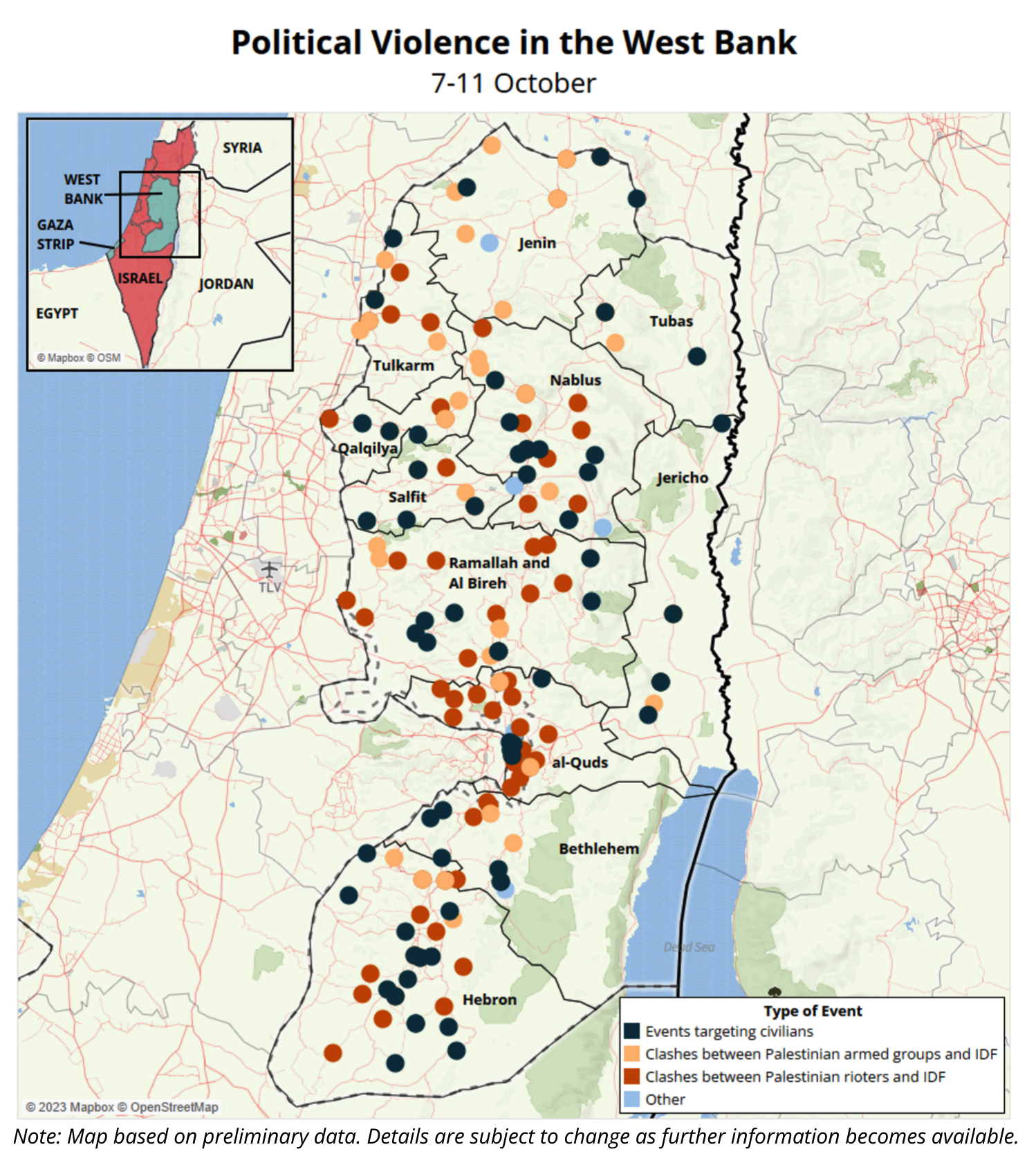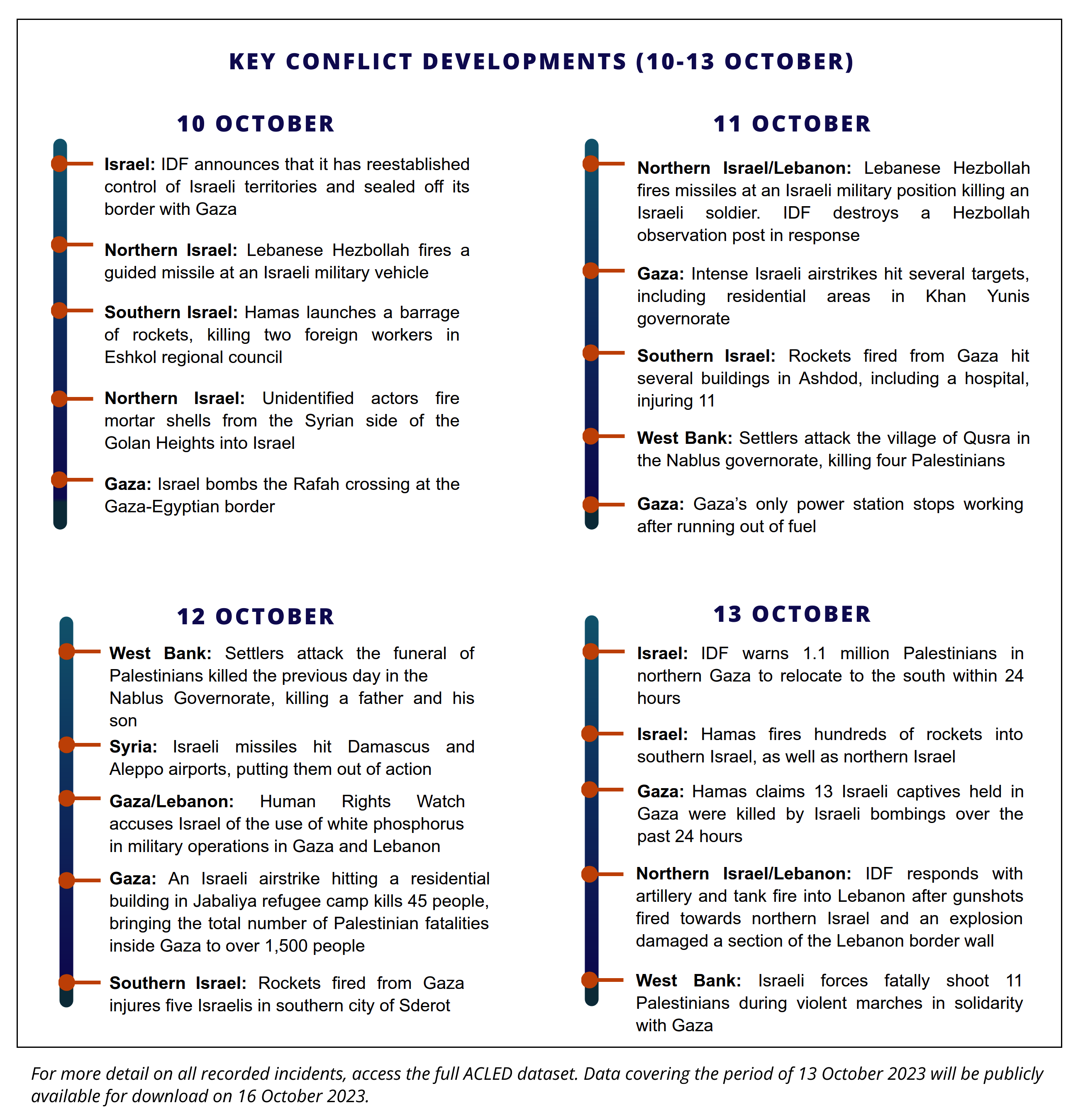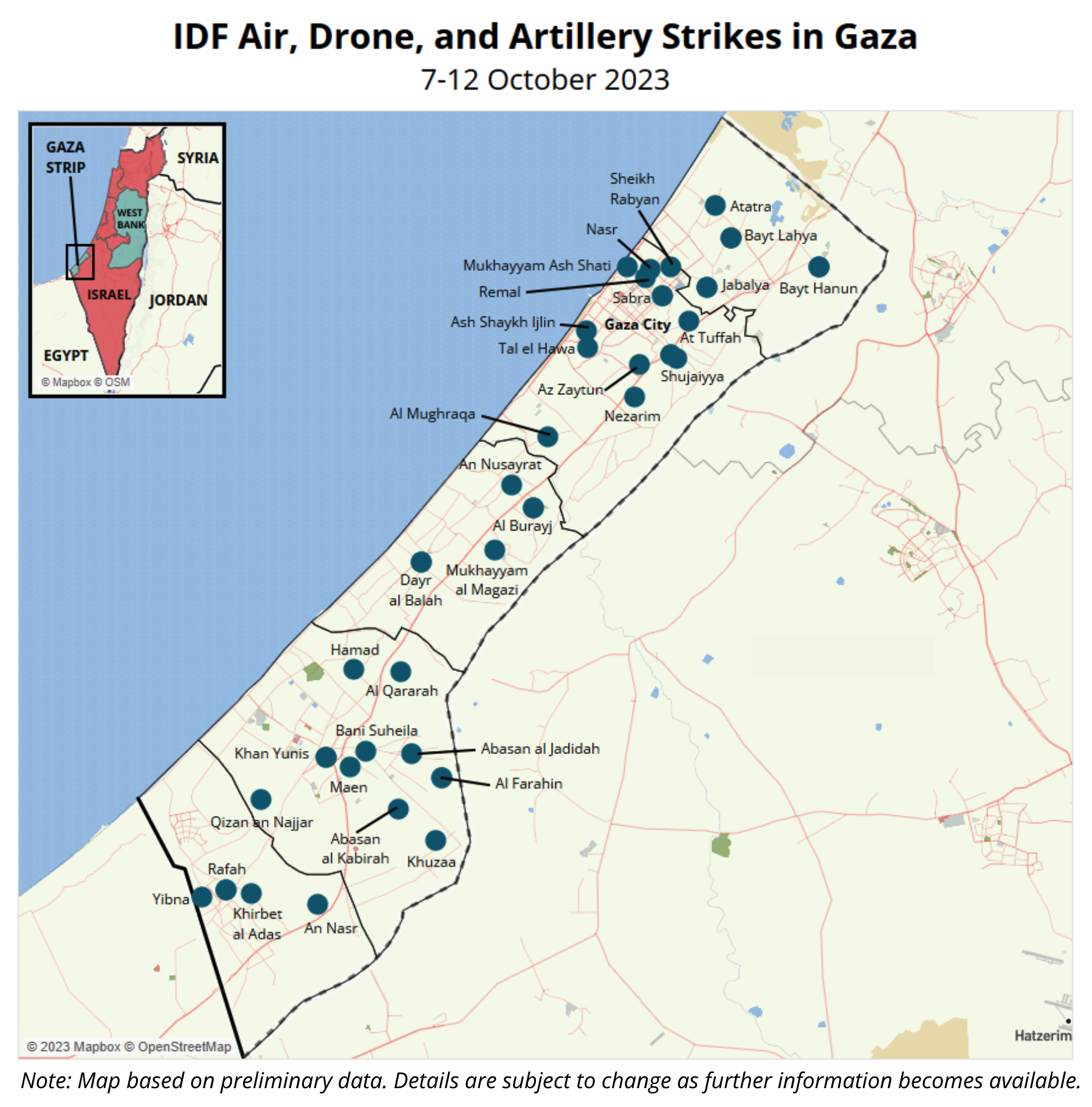- Get link
- X
- Other Apps
Posted by
Prateeti Rath
on
- Get link
- X
- Other Apps
Key Developments
Hamas Rocket Strikes into Southern Israel Continue as the IDF Reasserts Territorial Control
Violence inside Israel has abated since the Israel Defense Forces (IDF) announced it had regained control of all territories along the border with Gaza on 10 October, mining the area to prevent any renewed incursion, more than 72 hours after the Hamas surprise attack. Despite the announcement, a small number of Hamas militants have remained inside Israeli territory, with sporadic clashes reported until 13 October. The official Israeli death toll for the initial day of the Hamas assault has continued to rise, surpassing 1,300. The majority have been civilians, with the IDF putting the number of military fatalities at 264.
Hamas has also continued launching hundreds of rockets into Israel. While the majority of rockets have been intercepted by Israel’s Iron Dome air defense system, there have been a small number of direct hits. Two foreign workers were killed in Eshkol regional council on 10 October in a rocket attack, while about a dozen people were injured in Ashdod on 11 October. A further five Israelis were reported injured, two severely, in another rocket attack on 12 October in Sderot. At least one moderate and three light injuries were also reported on 13 October in Rehovot.
As of 13 October, Israel is still preparing for a potential ground invasion of Gaza, with a massive military buildup continuing along the border. But with Hamas holding an estimated 200 Israeli soldiers and civilians captured inside Gaza, the potential Israeli operation faces severe challenges. The Israeli military suggested on Thursday morning that no political decision regarding the launch of the ground operation had yet been made. Israel, however, issued a warning to Palestinians in northern Gaza on 13 October to relocate to southern Gaza within the next 24 hours, suggesting that a ground operation may be imminent.
Unprecedented Israeli Airstrike Campaign Targets Gaza
Since repelling the Hamas ground offensive, Israel has intensified its airstrikes on Gaza, which have killed nearly 1,800 people as of Friday afternoon. Densely populated residential areas in northern Gaza have been destroyed, with little indication that the Israeli military has tempered its response in the face of Hamas threats to execute hostages if airstrikes continue to hit civilian targets without warning. While satellite images suggest that entire neighborhoods have been leveled by the airstrikes, the IDF insists that it is only striking military targets. ACLED has so far recorded 23 distinct localities in all five Gazan governorates, as well as 10 neighborhoods and a refugee camp inside Gaza City, that have been bombarded by Israel during the period of 7-12 October (see map below). The retaliatory campaign is believed to be the most intense Israeli bombardment in the seven decades of conflict between Israel and Palestine.
Israel has also now put Gaza under a complete siege, with Israeli Defense Minister Yoav Gallant announcing that the coastal enclave would receive “no electricity, no food, no water, no fuel.” The majority of Gaza’s electricity comes from Israeli power lines, and its only power station ran out of fuel Wednesday, meaning that Gaza will soon be without electricity.
More than 420,000 Palestinians have been internally displaced. Egypt closed its border crossing with Gaza on Tuesday after Israeli forces bombed the area several times, and has said that it will not allow a mass exodus of Gazans across its border. In the wake of a 16-year blockade that had severely restricted the movement of goods and people, Gazan civilians are facing a humanitarian crisis.
Outbreaks of Violence Along Israel’s Northern Borders
Meanwhile, increasing regional tensions spilled over into armed violence on both sides of Israel’s northern borders with Lebanon and Syria (see map below). On 10 October, unidentified actors fired mortar shells from the Syrian side of the Golan Heights into Israel, without inflicting damage. The IDF targeted the source of the Syrian shelling with artillery and mortar fire. Israeli forces also simultaneously shelled airports in the Syrian capital Damascus and the northern city of Aleppo on 12 October, putting both airports out of service. While Israeli forces have attacked Iran-linked targets in Syria for years, including airports to disrupt Iranian supply, attacks of such scale — putting airports out of service — are rare. The shelling of the airport came ahead of a scheduled visit of Iranian Foreign Minister Hossein Amir-Abdollahian to Damascus. Iran, a close ally of Syrian President Bashar Assad and Lebanese Hezbollah, has strongly denied it had a role in the Hamas attack on Israel, but it has warned Israel that intensifying its campaign in Gaza may result in the conflict opening on “other fronts.”

Following tension on Monday when Israeli shelling killed three Hezbollah fighters after a cross-border infiltration attempt by Palestinian Islamic Jihad (PIJ) militants, Hezbollah fired a guided missile at an Israeli military vehicle on 10 October. In retaliation, Israel shelled at least 16 locations in the South and al-Nabatiye governorates of Lebanon. A day later, the group fired missiles at an Israeli military position near the border, killing one Israeli soldier. IDF helicopters responded by destroying a Hezbollah observation post. ACLED records eight other locations along the border that were shelled by Israeli forces. On 13 October, Israel once more shelled a Hezbollah post after gunfire targeted Israeli military posts near the border.
For now, there is no indication that Hezbollah is planning a large offensive of its own into Israel, with its limited activity likely aimed at keeping Israeli forces busy without provoking a full spillover into Lebanon. Israel likewise does not appear to want to open a second front while it deals with Hamas and its allies in Gaza. Yet, the escalating conflict and the developments on the ground in Gaza still have the potential to spiral into a wider regional war.
Escalation of Violence in the West Bank
Tensions in the West Bank have also continued to intensify. During the period of 7-12 October, ACLED records dozens of clashes between the Israeli military and Palestinian armed groups, including PIJ affiliates, Al-Aqsa Martyrs Brigade, and Hamas, resulting in at least 12 reported fatalities. On 12 October, an unidentified Palestinian gunman wounded two Israeli police officers in front of the police station in East Jerusalem and was subsequently shot dead. Furthermore, clashes between Israeli security forces and unarmed rioters left at least 20 Palestinians dead until 12 October. As thousands of people took to the streets to march in solidarity with Palestinians in Gaza on13 October, at least 11 demonstrators were killed in clashes with Israeli security forces across the West Bank. With Hamas leaders calling on Palestinians in the West Bank to join the conflict, the prospects that Israel will have to fight a multi-front campaign in the West Bank and Gaza remain high.

At the same time, Israeli settlers have escalated attacks against Palestinians, killing four on 11 October and a further two on 12 October in the Nablus area. On 13 October, a settler shot and severely injured an unarmed Palestinian at point-blank range, south of Hebron. With Israeli Minister of National Security Itamar Ben Gvir announcing the distribution of 10,000 rifles to “volunteer first response teams” in border towns, settlements in the West Bank, and mixed Jewish-Arab towns in Israel, there are serious concerns of a further deterioration of security in the West Bank, as well as inside Israel.


Comments
Post a Comment